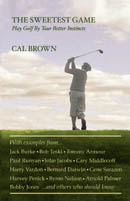New golf history explores the game’s appeal
April 8, 2005
I’ve re-discovered the secret of golf, thanks to Cal Brown’s new book, The Sweetest Game (Clock Tower Press; $22.95).
And I’ll even tell you what the secret is, although you’ll also enjoy reading the book and finding it out for yourself.
Brown certainly has the credentials to prove his case. A former writer and editor for Golf Digest magazine, he also spent many years with its instructional school, and wrote several golf books.
In the last century or so, several dozen players, writers, instructors, and others connected to the game have offered thousands of bits of advice and commentary about the game. Brown distilled some of the best parts into this eclectic collection of anecdotes, philosophical ramblings, war stories, character studies, and the occasional explanation of basic playing principles.
Brown also displays his own, nicely dry wit throughout the book. He dearly loves golf, but he knows better than to treat it with reverence: “The game is wicked. It is possible that some of you who glance through this book may not have discovered this, but you will.”
Of course, golf also has its undeniable delights, not least of which is found in its history.
There’s plenty in here for avid golfers no matter which era of the sport strikes their fancy. For every reference to Tiger Woods or Jim Furyk there are segments quoting Don January or Bob Toski, as well as Harry Vardon and Bobby Jones. Mixed in with stories of Arnold Palmer and Jack Nicklaus are similar tales of lesser-known but equally committed pros, such as Jerry Barber or Porky Oliver.
I loved the stories about Barber perhaps best of all, because in many respects he helps illustrate the secret to golf. For example, Brown describes how the 5-foot-6, bespectacled, short-hitting Barber won the 1961 PGA Championship.
In the final round in regulation, Barber hit into a tree adjacent to a par 3. The ball bounced onto the green three feet from the hole—birdie. Barber drove into more trees, recovered with a left-handed shot, smacked a four-wood to just short of the green, and pitched in for par. Barber hit a 130-yard duck hook, and took two more shots to reach the green forty feet from the hole, then made his putt. On the last hole, Barber then sunk a 60-foot putt across a diagonal ledge, forcing a playoff that he won the next day by a stroke.
Now, does any of that sound like your own experience, either for how you played or how you lost to someone playing with you?
The secret of golf is that there are no secrets. There is no one way to swing, no one way to chip, no one way to putt, no one way to score. There are a few basic elements to playing the game well, however, and on that issue Brown frequently quotes John Jacobs, a great former professional player and accomplished teacher.
Jacobs understood and could make others understand and apply the simple physics of the game. The other ninety percent of golf is a matter of remembering the basic goal of scoring with as few strokes as possible under the circumstances, and not caring too much about how one plays to achieve it.
Golfers looking for step-by-step instructions on how to play won’t find them here. On the other hand, golfers looking for useful insight, frequently amusing and sometimes profound, are in luck.
Cape Beats Delmar
On April the Cape Henlopen Vikings won their second match of the season, beating Delmar 156-195 at the Nutters Crossing golf course near Salisbury, Maryland, on a beautiful spring day.
John Purple and Jason Hastings took co-medalist honors with a pair of 2-over-par 37s. Andrew Schneider shot a nice 40, while Andrew Parsell surprised Coach Claudio Smarelli with a 42. “That was well under what he’s been doing in practice,” Smarelli said. “All of them hit the ball solid. I’m sure they were glad to play for once in halfway decent weather.”


